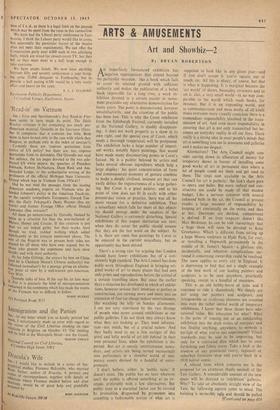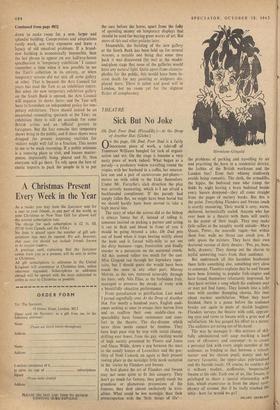ARTS & AMUSEMENTS
Art and Showbiz-2
By BRYAN ROBERTSON
AN imperfectly formulated exhibition has jAnegative repercussions that extend beyond the particular occasion: like a book which fails to cover its selected ground with sufficient authority and makes the publication of a better book impossible for a long time, a weak ex- hibition devoted to a certain master or move- ment precludes any alternative demonstration for many years. The point is demonstrated, however unsatisfactorily, and the attention of the public has been lost. This is why the Corot exhibition from the Edinburgh Festival, currently installed at the National Gallery, is doubly disappoint- ing: it does not work properly as a show in its own right, and the special case of Corot, which needs a thorough reappraisal, will. be postponed. The exhibition lacks a large number of import- ant works, notably figure paintings, that would have made many disconcerting points in Corot's favour. He is a painter beloved by artists and lacks several obvious ingredients which help a large display : his quiet concentration of form and commensurate economy of gesture combine to make a deeply civilised, intimate art that can easily defeat the expansiveness of a large gather- ing. But Corot is a great painter, and as his point of view does not fit in easily with either present-day vision or practice, there was all the more reason for, a definitive exhibition. That a miscellany which falls far short of this object- ive should emerge under the auspices of the National Gallery is extremely disturbing. Special exhibitions at this august institution are rare; when they do occur the public should assume that they are the last word on the subject. As it is, there are some fine paintings by Corot to be enjoyed in the current miscellany, but an opportunity has been missed.
There's a strong case for arguing that London should have fewer exhibitions but of a con- sistently high standard. The Arts Council has done noble work throughout England in bringing ori- ginal works of art to many places that had seen only prints and reproductions before the arrival of a certain travelling show. But since the earlier days a situation has developed in which art exhibi- tions, however serious their intention or perfect in construction, are turning more and more into an extension of free (or cheap) indoor entertainment, like watching the telly on Sunday afternoons. I am not very convinced by the vast throngs of people who move around exhibitions at our public galleries. I do not think they always know what they are looking at. They need informa- tion--not much, but of a crucial nature. And they badly need to see a few vestiges of this great and lofty world of art left behind, in their own personal lives, when the exhibition is dis- persed. But art is merely entertainment nowa- days, and artists are being turned increasingly into performers in a showbiz world of tem- porary events devised by a handful of entre- preneurs. I don't believe, either, in 'public taste.' It doesn't exist. The public has no taste whatever until the public is offered something as an ex- ample, preferably with a few alternatives. But public taste as a marginal factor can be created by proniotion, dragooned by promoters into accepting a fashionable notion of what art is
supposed to look like in any given year—and if you don't accept it, you're square, out of touch, etc. All this is idiocy, of course, but that
is what is happening. It is marginal because the 'art world' of shows, biennales, reviewers and so on is, alas, a very small world—in no way com- parable to the world which reads books, for instance. But it is an expanding world, and as communications and mass media of all kinds make everyone more visually conscious there is a tremendous responsibility involved in the trans- mission of art. And even more responsibility in ensuring that art is not only transmitted but be- comes an everyday reality in all our lives. There really is a strong idea in most people's minds that art is something you see in museums and galleries and it makes me despair.
Alternatives? The Arts Council might con-
sider cutting down its allocation of money for temporary shows in favour of installing some good works of art in permanent sites where a lot of people could see them and get used to them. The total sum available to the Arts Council for art is pathetic: the lion's share goes to opera and ballet. But more radical and con- structive use could be made of that modest budget. Like a nervous conjuror with several coloured balls in the air, the Council at present evades a large measure of responsibility by keeping art continually on the move, and thus at bay. Decisions are shirked, commitment is shelved. If an irate taxpayer doesn't like Max Beckman, he can be told reassuringly that a huge show will soon be devoted to Kate Greenaway. Which is different from setting up a huge Moore sculpture in Hyde Park, for ever, or installing a Hepworth permanently in the middle of St. fames's Square—a glorious site, incidentally, and whatever complications sur- round it concerning ownership could be resolved. The same applies to every city in England. It is depressing to find that not a single example of the best work of our leading painters and sculptors is to be seen anywhere, practically speaking, except in a handful of museums.
This is an old hobby-horse of mine and I
continue to ride it shamelessly. We simply are not using our painters and sculptors; and irresponsible or irrelevant elements are creeping into even the rather unreal world of temporary exhibitions. I know that these shows have edu- cational value. But education for what? What is the point of coming out of an exhilarating exhibition into the drab streets of everyday and not finding anything, anywhere, to embody a particle of what you've just experienced? Visual standards may be said to be improving, but only for a cultivated elite which has its own furnishing and fabric stores. Take a look at the window of any provincial (sorry, regional) or suburban furniture shop and you're back in a 1938 horror comic.
A related issue which concerns me is the proposal for an extension (badly needed) of the Tate Gallery. A considerable amount of the new space will be devoted to 'exhibition' galleries. Why? To take an absolutely straight view of the Tate, the following aspects come to mind. The building is invincibly ugly, and should be pulled [Continued on page 484
Continued from page 4811
down to make room for a new, larger and splendid building. Compromises and adaptations rarely work, are very expensive and leave a legacy of old unsolved problems. If a brand- new building is economically impossible, then the last phrase to appear on any halfway-house specification is `temporary exhibition.' I cannot remember a time when it was possible to see the Tate's collection in its entirety, or when temporary screens did not seal off some gallery or other. That is because the Arts Council for years has used the Tate as an exhibition centre. But when the new temporary exhibition gallery on the South Bank is opened, the Arts Council will organise its shows there; and the Tate will have to formulate an independent policy for tem- porary exhibitions. There should indeed be an occasional resounding spectacle at the Tate: an exhibition there is still an accolade for some British artists and an 'official' gesture to foreigners. But the fact remains that temporary shows bring in the public, and if these shows were dropped the present imposing statistics for visitors might well fall to a fraction. This seems to me to be weak reasoning. If a public museum is a stunning place to visit, and houses master- pieces, impeccably hung, placed and lit, then everyone will go there. To rely upon the lure of exotic imports to pack the people in is to put
the cart before the horse, apart from the folly of spending money on temporary displays that should be used for buying great works of art. But more of this and other policies later.
Meanwhile, the building of the new gallery at the South Bank has been held up for several reasons, a notable one being that some time back it was discovered (by me) at the model- and-plans stage that none of the galleries would have any natural light. Quite apart from claustro- phobia for the public, this would have been in- stant death for any painting or sculpture dis- played there. There is talent and good will in London, but no room yet for the slightest flicker of complacency.







































 Previous page
Previous page